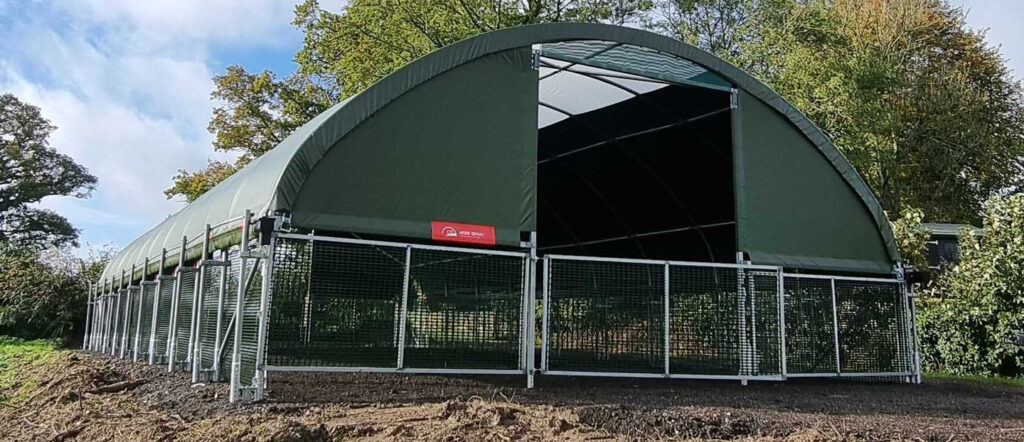Modular livestock structures are making waves by transforming the productivity and yields in modern livestock farming—they provide the animals with a healthy and comfortable environment to thrive.
Deploying them on farms can lead to an increased productivity and yields from commercial flocks, a reduction in costs incurred for treating ailments or mortality among unhealthy animals, and an increased revenues and profitability.
Providing immensely more returns and being far less expensive than constructing dedicated traditional farm buildings for housing livestock, these modern structures deliver results rapidly, keep maintenance low, and perform exceptionally—while falling within limited budgets.
Here’s a rundown of how these structures can generate impressive returns for livestock farms and agribusinesses and meet all livestock housing requirements when deployed correctly.
Improved health and productivity for livestock and poultry
Modular livestock structures provide a controlled environment for animals, protecting them from harsh weather conditions, such as extreme heat, cold, and wind.
This results in improved health and productivity of the animals, as they are able to thrive in a more consistent environment. Additionally, you can reduce the need for veterinary care because the controlled environment created by the shelter allows for more precise animal management.
They also enable farms to curb the spread of diseases among animals by facilitating better sanitation and biosecurity measures.
Controlled environments for increased feed efficiency
Another major advantage of using modular livestock structures for housing cattle, sheep, goats, and ground-nesting birds in farms is their ability to increase feed efficiency.
Deploying them allows farms to establish optimal controlled environments that meet their ideal livestock housing requirements. Through these conditions, farms can control the temperature and humidity levels which can help improve digestion and absorption of feed by animals.
This can lead to less feed being required to produce the same amount of meat, milk, or eggs, resulting in significant cost savings for your farm. Furthermore, using modular livestock houses can help you reduce feed waste, providing even more cost savings and better control over feeding-related expenditures.
Higher effectiveness in planning and control
When it comes to livestock and poultry production, proper planning and control are crucial, and commercial farming operations can do a better job of this by utilising modular structures instead of traditional farm buildings to meet their livestock housing requirements.
Modular livestock houses enable farms to create a more consistent and high-welfare environment for their animals, enabling them to plan the breeding and feeding schedules more effectively, take advantage of market conditions, and maximise profits.
Moreover, the use of personalised layouts of modular structures can also allow farms to raise different types of animals by creating different microclimates within the same layout as well as with penned-off and separated enclosures within the structure.
This can be particularly beneficial for small farms and agribusinesses, allowing them to diversify their livestock and poultry offerings to increase income potential.
Increased flexibility and adaptability
Another notable benefit of using modular livestock structures in farms is that they allow agribusinesses to be more flexible and adaptable in the face of changing market conditions and weather patterns.
For example, if a severe weather event occurs, farms can quickly relocate their livestock houses to a more sheltered location on the property to further protect commercial flocks from the elements. Additionally, the use of modular livestock houses can help agribusinesses take advantage of new market opportunities, as they allow farms to raise animals in more natural climates, making it easier to meet organic and free-range standards to fetch a higher value on products sold.
Furthermore, using a modular and scalable livestock structure can allow farms to conveniently change the layout or scale of their shelters to better meet the ever-changing needs of the broader market or address evolving internal livestock housing requirements, with little cost or effort.
Maximise the returns from your farm and meet livestock housing requirements with ease
Regardless of the scale and nature of your livestock or poultry farming operation, investing in high-quality modular livestock housing can help you provide your animals with high-welfare housing, which in turn, will help reduce costs, improve productivity, and allow you to be more flexible.
Agri Span by McGregor Structures is a proven solution that has delivered unmatched performance and powerful results to livestock operations across the UK.
So If you are seeking the most robust and durable structures for livestock housing, a simple inquiry with our team that specialises in agricultural shelters and structures can yield expert insights that you can leverage to generate the impressive returns you desire from your farm.

